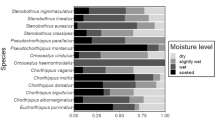Summary
The relationship between embryonic postdiapause development (PDD) and temperature in ten Acridid species was studied by culturing eggpods from diapause onwards at constant temperatures (ranging from 15.0° C to 37.5° C). In six species PDD was also studied at fluctuating temperatures (12 h at 27.5° C and 12 h at 13.0° C). The PDD duration was strongly temperature dependent in all species studied (Q10 values between 3.0 and 4.1) and differed greatly between species. To assess whether these differences affect habitat determination, PDD duration was related to habitat microclimate. We found that species with a relatively long PDD are restricted to relatively warm grasslands, while species with a short PDD are also found in colder grasslands. Two species have a more limited occurrence than predicted from PDD duration. It is argued that the length of PDD (and consequently hatching date) is crucial to the completion of the annual cycle. The results are applicable to conservation of grasshoppers in grasslands subject to eutrophication. Here increase of vegetation density and height will lead to lower maximum temperatures in the egg environment (i.e. near the soil surface) and consequently to a delay in hatching and loss of thermophilous species. Grassland management rules are proposed that should aid conservation of these species.
Similar content being viewed by others
References
Barkman JJ, Stoutjesdijk Ph (1987) Microklimaat, vegetatie en fauna. Pudoc, Wageningen
Choudhuri JSB (1958) Experimental studies on the choice of oviposition sites by two species ofChorthippus (Orthoptera: Acrididae). J Anim Ecol 27:201–216
Franz H (1931) Über die Bedeutung des Mikroklimas für die Faunenzusammensetzung auf kleinem Raum. Z Morph Ökol Tiere 22:587–628
Franz H (1933) Auswirkungen des Mikroklimas auf die Verbreitung mitteleuropäischer xerophiler Orthopteren. Zoogeographica 1:551–565
Hunter-Jones P (1970) Factors affecting egg-survival in Acridoidea. Proc Int Study Conf Current and Future Problems of Acridology. London, pp 111–115
Ingrisch S (1981) Zur Verbreitung der Orthopteren in Hessen. Mitt Int Ent Ver 6:29–58
Ingrisch S (1983) Zum Einfluß der Feuchte auf die Schlupfrate und Entwicklungsdauer der Eier mitteleuropäischer Feldheuschrecken (Orthoptera: Acrididae). Dtsch Entomol Z 30:1–15
Ingrisch S (1987) Die Geradflügler (Orthopteroidea, Dermaptera and Blattaria) des Mainzer Sandes. Mainzer Naturw Arch 25:233–252
Ingrisch S, Boekholt I (1983) Zur Wahl des Eiablageplatzes durch mitteleuropäische Saltatoria. Zool Beitr NF 28:33–46
Jacovlev V (1957) Wasserdampfabgabe der Acrididen und Mikroklima ihrer Biotope. Zool Anz (Leipzig) 20:136–142
Jacovlev V (1959) Mikroklimatische Untersuchungen in einigen Acrididenbiotopen. Z Morph Ökol Tiere 48:89–101
Jacovlev V, Krüger F (1953) Vergleichende Untersuchungen zur Physiologie der Transpiration der Orthopteren. Zool Jahrb Abt Allg Zool Physiol Tiere 64:391–428
Joern A (1982) Vegetation structure and microhabitat selection in grasshoppers (Orthoptera, Acrididae). Southwest Nat 27(2):197–207
Kaltenbach A (1963) Milieufeuchtigkeit, Standortsbeziehungen und ökologische Valenz bei Orthopteren im pannonischen Raum Österreichs. Sitzungsber Österr Akad Wiss Wien (I) 172:97–119
Kelly-Stebbings AF, Hewitt GM (1972) The laboratory breeding of British gomphocerine grasshoppers (Acrididae: Orthoptera). Acrida 1:233–245
Luneau C (1950) Zur Heuschreckenfauna Schleswig-Holstein. Schr Naturwiss Ver Schleswig-Holstein 24:51–56
Marchand H (1953) Die Bedeutung der Heuschrecken und Schnabelkerfe als Indikatoren verschiedener Graslandtypen. Beitr Entomol 3:116–162
Moriarty F (1969) The laboratory breeding and embryonic development ofChorthippus brunneus (Thunberg) (Orthoptera: Acrididae). Proc R Ent Soc Lond A 44:25–34
Oschmann M (1973) Untersuchungen zur Biotopbindung der Orthopteren. Faun Abh Staatl Mus Tierk (Dresden) 4:177–206
Otte D, Joern A (1977) On feeding patterns in desert grasshoppers and the evolution of specialized diets. Proc Acad Nat Sci (Philadelphia) 128:89–126
Röber H (1949) Insekten als Indikatoren des Mikroklimas. Naturw Rundsch 2:496–499
Sänger K (1974) Beobachtung über die Schlüpfrate einiger Feldheuschrecken (Orthoptera: Acrididae). Verh Zool Bot Ges Wien 114:21–27
Sänger K (1977) Über die Beziehungen zwischen Heuschrecken (Orthoptera: Saltatoria) und der Raumstruktur ihrer Habitate. Zool Jahrb Syst (Jena) 104:433–488
Schmidt GH (1961) Wasserhaushalt und Insektenleben. Naturw Rundsch 14:420–427
Schmidt GH, Bühl J (1970) Biotopmäßige Verteilung der Orthoptera-Gemeinschaften in der Umgebung eines Französischen Alpensees (Lac du Bourget). Zool Beitr NF 16:1–72
Sokal RR, Rohlf FJ (1969) Biometry. The principles and practice of statistics in biological research. WH Freeman and Company, San Francisco
Uvarov BP (1966) Grasshoppers and Locusts, Volume I. Cambridge University Press
Wingerden WKRE van, Bongers W (1989) Verspreiding vanStenobothrus stigmaticus (Rambur) 1839 (Orthoptera, Acrididae) in relatie tot de vegetatiestructuur vanDeschampsia flexuosa bij begrazing. Nieuwsbrief Saltabel 2:20–27
Wingerden WKRE van, Musters JCM, Kleukers RMJC, Bongers W, Biezen JB van (1991) The influence of cattle grazing on grasshopper abundance (Orthoptera: Acrididae). Proc Exper. & Appl. Entomol., N.E.V. Amsterdam, Vol 2:28–34
Author information
Authors and Affiliations
Rights and permissions
About this article
Cite this article
van Wingerden, W.K.R.E., Musters, J.C.M. & Maaskamp, F.I.M. The influence of temperature on the duration of egg development in West European grasshoppers (Orthoptera: Acrididae). Oecologia 87, 417–423 (1991). https://doi.org/10.1007/BF00634600
Received:
Accepted:
Issue Date:
DOI: https://doi.org/10.1007/BF00634600




